Abstract
Objective:
This study analyzes the research output of India in asthma during the period from 1999 till 2008. It analyzes the growth, rank and global publications share, citation impact, share of international collaborative papers, contribution of major collaborative partner countries and contribution of various subject fields. It also analyzes the characteristics of most productive institutions, authors and high-cited papers.
Materials and Methods:
SCOPUS database has been used to retrieve the data on publication output in asthma research.
Results:
India ranks 15th position among the top 23 countries in asthma research, with its global publication share of 1.27% (862 papers), registering an average citation per paper of 3.43 and achieved an h-index of 33 during 1999-2008.
Conclusion:
Indian research output on asthma is quite low in the global context as reflected from its publication output per thousand population (0.001) and its world publication share (1.27%) during 1999-2008. Also, the impact and quality of Indian research is low compared to select developed and developing countries.
KEY WORDS: Asthma, India, publication output
INTRODUCTION
Asthma is a major chronic lung disease characterized by recurrent attacks of breathlessness and wheezing, which vary in severity and frequency from person to person. Although the fundamental causes of asthma are not completely understood, numerous antigens/allergens are capable of triggering the acute attacks of asthma.[1] Asthma is classified into several forms on the basis of cause of asthma symptoms, its severity, method of its control, and its prevalence among populations of different age groups.[2,3]
In the recent years, the morbidity and mortality of population due to asthma is increasing despite the advances being made in understanding of this disease and availability of improved medications and information on treatment.[4] As per WHO estimates 2007, there are 300 million people currently suffering from asthma globally (a number that could increase by further 100 million by 2025) and 255,000 people died of asthma in 2005.[5–9] Most asthma related deaths occur in low- and lower-middle income countries. Prevalence rates of asthma are higher in western countries than in Asian countries.[6] Although the prevalence of asthma in India is somewhat similar to that seen in other Asian countries, the asthma incidences have increased significantly over the years in the country.[7] As per National family health survey of India, 2468 persons per 100,000 population are reported to be suffering from asthma, which is considerably higher in rural areas (2649 per 100,000 population) than in urban areas (1966 per 100,000 population).[8] According to the global burden of asthma report (GINA), over 50 million suffer from asthma in Central and Southern Asia and an absolute 2% increase in the prevalence of asthma in India would result in an additional 20 million people with this disease.[9]
Objectives
The main objective of this study was to analyze the research performance of India on asthma, in the national and global context, as reflected in its publications output during 1999-2008. In particular, the study focuses on analyzing the following: (i) the Indian research output, its growth, rank and global publications share and impact; (ii) the patterns of international collaboration and major collaborative partners; (iii) the contribution by sub-fields of asthma; (iv) the patterns of research output among various types of asthma; (v) the publication productivity and impact of leading institutions and authors of India and (vi) the characteristics of high-cited papers.
Review of literature
Very few studies have been undertaken in the past on worldwide asthma research activities. Klaewsongkram and Reantragoon[10] analyzed the asthma research of Asia-Pacific countries during 1998-2007 using PUBMED database. Among the Asia-Pacific countries, Australia and Japan are the leading countries in contributing the highest research output on asthma. Similarly, New Zealand and Australia are the leading countries in receiving highest impact (in terms of citations count per paper) for their publications as well as for publishing them in high-impact journals. There was a drastic increase in the number of asthma publications and its quality from South Korea, Taiwan, Hong Kong and Singapore in the last decade. Although the publication output of China and India on asthma research has increased during 1998-2007, it is of low quality.
Chen, Chiu and Ho[11] made the bibliometric study of publications output on asthma in children during 1991-2002 using SCI online version database. The parameters analyzed included language of publications, types of document, page count, publication output by country, authorship pattern and the most frequently cited papers. In addition, performance of research workers, institutions and countries based on publications and citations data had been undertaken. Groneberg-Kloft et al.[12] conducted a scientometric study on the research activities of two obstructive airway diseases, bronchial asthma and chronic obstructive pulmonary disease, during 1987-2006 using Web of Science database. The study compared 8874 publications (with 20.55% of their publications involving international collaboration and scoring a citation impact of 24.48 per paper) from UK and 3341 publications (with 27.63% of their publications involving international collaboration and scoring a citation impact of 17.62 per paper) in asthma research. Poureslami et al.[13] conducted a systematic review of publications on asthma, health and literacy topic during 1980-2006 using various databases to find the link between asthma and health literacy in a cultural ethnic perspective in Canada.
MATERIALS AND METHODS
Source of data
This study was based on the Indian publication data in asthma, retrieved from the Scopus Citation database, for 10 years (1999-2008). The search strategy/keyword used to retrieve the data on asthma was “asthm*”. To retrieve the Indian articles on asthma, the following string was used in Scopus database:
(AFFIL(India) AND TITLE-ABS-KEY(asthm*)) AND PUBYEAR AFT 1998 AND PUBYEAR BEF 2009.
Similarly, the research output of other countries had been retrieved with this string. For retrieving the population of these countries, Wikipedia had been used.[14] “Limit To” option of Scopus database was used to retrieve the data on different sub-fields by clicking on the concerned subject one by one with the above-mentioned main string. For searching the research output on various types of asthma, the keywords used were allerg*, occupa*, exerc*, noctur*, child*, adult* season* in TITLE-ABS-KEY and these searches were combined with the main string.
For citations data, 4-year, 3-year and 2-year citations window had been used for computing average citations per paper in asthma research during 1999-2006, 2007 and 2008. However, for high-cited papers, the total citations had been used. Multilateral, Bilateral, National and Zero Collaborations in high-cited papers means the collaborative papers of India with more than two countries, with only two countries, with national institutions only and with no collaborations, respectively. For calculating the total international collaborative papers, a separate search strategy that combines India's collaboration with 140 major countries was prepared. For analyzing and generating institutional and authors’ output, separate search strategies were developed.
RESULTS
World asthma research output and ranking of countries
The research output, publication share and ranking of top 23 countries of world in asthma research during 1999-2008 are presented in Table 1. The publication share of these 23 countries varies from 0.30 to 26.12% in global publication output during 1999-2008. United States scores the 1st position with a publication share of 26.12% and United Kingdom comes 2nd with a publication share of 11.37%. Germany, Japan, Canada, France, Italy, Australia and The Netherlands are placed from 3rd to 9th positions with publications share ranging from 5.49% to 3%, respectively. The countries that rank between 10th and 19th positions are Spain, Sweden, China, Poland, Switzerland, India, Belgium, Turkey, Brazil and South Korea, with their global publications share ranging from 1 to 2.99%. Of the 23 countries, 16 witnessed increase in their publication share from the year 1999 to the year 2008. India ranks 15th position among these top 23 countries in asthma research by contributing 1.27% of the publications share in world asthma research during 1999-2008. India's global publication share rose from 0.89% in 1999 to 1.79% in 2008 and its world ranking improved from 14th to 13th during the same period [Table 1].
Table 1.
Ranking of top 23 countries in asthma research (years 1999 and 2008)
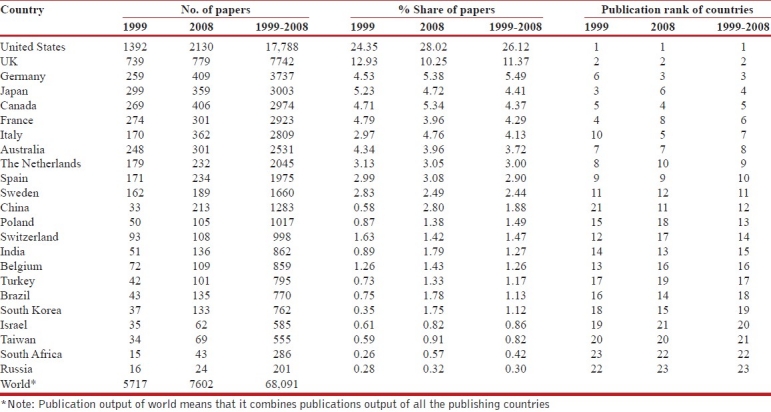
On comparing the asthma publications output vis-à-vis the population of the leading countries, India's publications output per thousand publications was the lowest among the 23 countries considered in the study as seen from Table 2.
Table 2.
Asthma publications output during 1999-2008 and population density of leading countries
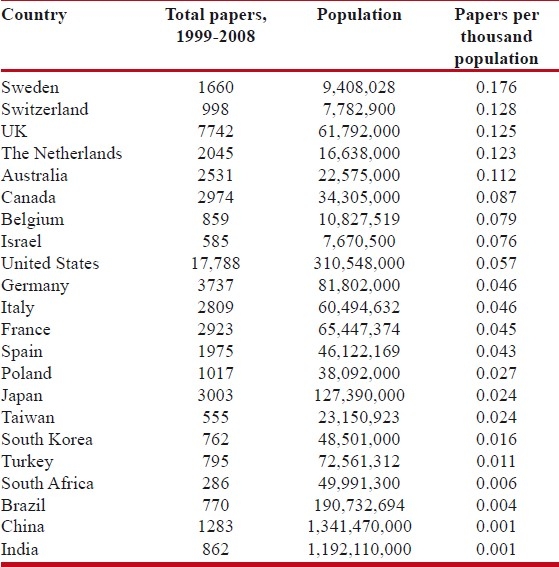
Research profile of Indian asthma research, 1999-2008
The Indian research output, its impact in terms of average citation per paper and the percentage share of international collaborative papers on asthma during the 10 years from 1999 to 2008 is presented in Figure 1. The cumulative research output consists of 862 papers during 1999-2008, with an average number of 86.2 papers per year, rising from 333 papers during 1999-2003 to 529 papers during 2004-2008, showing a growth rate of 58.86% and registering an h-index of 33. This cumulative Indian publications output in asthma received 2959 citations, registering an average of 3.43 citations per paper. The citation impact per paper of total Indian publications rose from 2.87 during 1999-2003 to 3.79 during 2004-2008 [Table 3a] However, the citation impact of Indian research in asthma was much lower than the citation impact of select developed and developing countries’ publications [Table 3b]. The share of international collaborative output accounted for 10.09% share (87 collaborative papers) in the cumulative research output of India in asthma research during 1999-2008. India's share of international collaborative papers in its total research output in asthma research showed a significant increase, rising from 6.01% during 1999-2003 to 12.67% during 2004-2008 [Table 3a].
Figure 1.
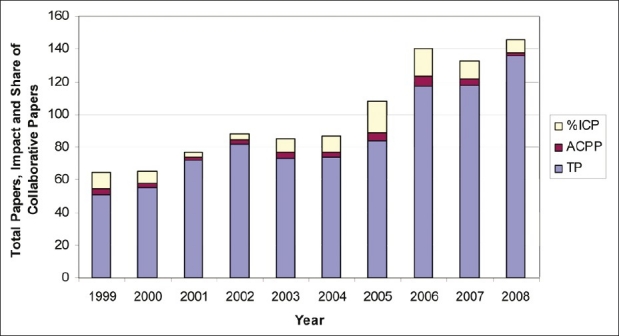
Indian research performance in Asthma Pulblications (period 1999-2008)
Table 3a.
Indian asthma research output during block years (1999-2003, 2004-2008 and 1999-2008)

Table 3b.
Citations impact of select developed and developing country papers in asthma research, 1999-2008

Among the collaborative partners of India, USA contributed the largest publications share of 51.72% share (45 papers) during 1999-2008, followed by UK with 25.29% publications share (22 papers), Germany with 9.20% publications share (8 papers), France and Australia with 8.05% publications share (7 papers), etc. [Table 4].
Table 4.
India's international linkages with major countries in asthma research (period 1999-2008)
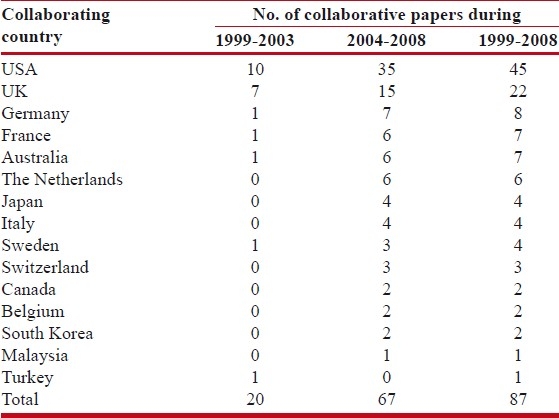
Contribution of various sub-fields in asthma research in India
Analysis of asthma research output in the context of different subjects revealed that 62.88% (542 papers) of the total Indian research output have been in medicine, followed by pharmacology, toxicology and pharmaceutics (23.20% share and 200 papers), biochemistry, genetics and molecular biology (15.66% share and 135 papers), immunology and microbiology (8.12% share and 70 papers), chemistry (6.84% share and 59 papers) and agricultural and biological sciences (4.18% share and 36 papers). All these subject fields witnessed an increase in their publications share from 1999-2003 to 2004-2008 [Table 5].
Table 5.
India: Sub-fields distribution of papers in asthma research, 1999-2008

Considering the citation impact and quality, the research output under immunology and microbiology registered the highest impact of 6.70 citations per paper, followed by pharmacology, toxicology and pharmaceutics (5.05 citations per paper), chemistry (4.46 citations per paper), biochemistry, genetics and molecular biology (3.91 citations per paper), medicine (2.85 citations per paper) and agricultural and biological sciences (1.44 citations per paper). Except immunology and microbiology, all other subjects witnessed an increase in their citation quality and impact in terms of average citations per paper from 1999-2003 to 2004-2008. The research output under medicine scored the highest h-index value of 22, followed by pharmacology, toxicology and pharmaceutics (20), immunology and microbiology (14), biochemistry, genetics and molecular biology and chemistry (13 each) and agricultural and biological sciences (5) [Table 5].
Patterns of research output among various types of asthma and it prevalence in different age groups of population
Among the various types of asthma (with their respective publication share in Indian and world output), the largest emphasis had been on allergic asthma (27.49% and 35.25% share), followed by occupational asthma (4.18% and 5.08% share), seasonal asthma (4.18% and 3.69% share), exercise-induced asthma (2.55% and 4.03% share) and nocturnal asthma (1.97% and 0.95%) during 1999-2008. However, in terms of India's global publications share, the largest emphasis (2.62% publications share) had been on nocturnal asthma, followed by seasonal asthma (1.43% share), occupational asthma (1.02% share), allergic asthma (0.99% share) and exercise-induced asthma (0.80% share) during 1999-2008. India's global publications share had increased in allergic asthma (from 0.75 to 1.16%), occupational asthma (from 0.93 to 1.11%) and seasonal asthma (from 0.97 to 1.75%), as against a decrease in exercise-induced asthma (from 0.88 to 0.74%) and nocturnal asthma (from 2.71 to 2.53%) from 1999-2003 to 2004-2008 [Table 6].
Table 6.
Classification of Indian and world publication output by type of asthma, 1999-2008

On analyzing the research output published as per asthma prevalence in different age groups of population as reflected in asthma studies (with their respective publication share in Indian and world output), the largest emphasis had been on infant, adolescent and child (31.32% and 30.26% share), followed by adult and middle-aged (29.58% and 30.24% share) and aged and elderly (6.15% and 10.22% share) during 1999-2008. However, in terms of India's global publications share, the largest emphasis had again been on infant, adolescent and child (with 1.31% publications share), followed by adult and middle-aged (1.24% share) and aged and elderly (0.76% share) during 1999-2008. India's global publications share had increased in infant, adolescent and child (from 1.28 to 1.34%), adult and middle-aged (from 0.82 to 1.61%) and aged and elderly (from 0.54 to 0.95%) from 1999-2003 to 2004-2008 [Table 7].
Table 7.
Publication distribution by prevalence of asthma in different age levels of population, 1999-2008

Research profile of major Indian institutions engaged in asthma research
The research profile of 13 most productive Indian institutions engaged in asthma research is presented in Table 8. The cumulative publications output of these 13 productive institutions together contributed 45.94% share (396 papers) in the total publications output in asthma research during 1999-2008, with an average of 30.46 papers per institute. Only four institutions, Postgraduate Institute of Medical Education and Research, Chandigarh (91 papers), All India Institute of Medical Sciences, New Delhi (80 papers), Institute of Genomics and Integrated Biology, Delhi (66 papers), and Vallabhbhai Patel Chest Institute, New Delhi (64 papers), have registered higher number of papers than the group's average. The average citation received per paper by the total papers published by these 13 productive institutions is 3.75. Four institutions registered higher impact than the average impact (3.75) of all 13 productive institutions. These are University Institute of Pharmaceutical Sciences, Panjab University (8.80 citations), Institute of Genomics and Integrated Biology (5.71 citations), KEM Hospital (4.25 citations), and Vallabhbhai Patel Chest Institute, New Delhi (4.06 citations). Only 5 out of 13 institutions registered higher h-index value than the average h-index value (6.69) of all 13 productive institutions [Table 8].
Table 8.
Contribution and productivity of major Indian institutions in asthma research, 1999-2008

Research profile of prolific Indian authors engaged in asthma research
Top 14 authors, who had published 12 and more papers in asthma research during 1999-2008, have been identified as the most productive and their research performance profile is presented in Table 9. The combined contribution of these 14 authors accounts for 31.90% share (275 papers) in the country's output in asthma, with average productivity of 19.64 papers per author. Seven authors have contributed higher publications than the group's average. These are B. Ghosh with 33 papers, followed by D. Gupta, S. K. Kabra, S. K. Chhabra (26 papers each) and A. Shah, R. Lodha, M. Singh (20 papers each). The average citation impact as measured by average citations per paper registered by these 14 authors for all of their publications is 4.18 citations per paper. Six authors have recorded higher impact than the group's average. These are B. Ghosh with 6.76 citations per paper, followed by J. Batra (6.08 citations), A. Shah (5.45 citations), S. K. Jindal (5.344 citations), S. K. Chhabra (5.15 citations) and A. N. Aggarwal (4.61 citations). These authors together have achieved average h-index value of 6.14. Seven authors registered higher h-index value than the group's average [Table 9].
Table 9.
Contribution and productivity of prolific Indian authors in asthma research, 1999-2008
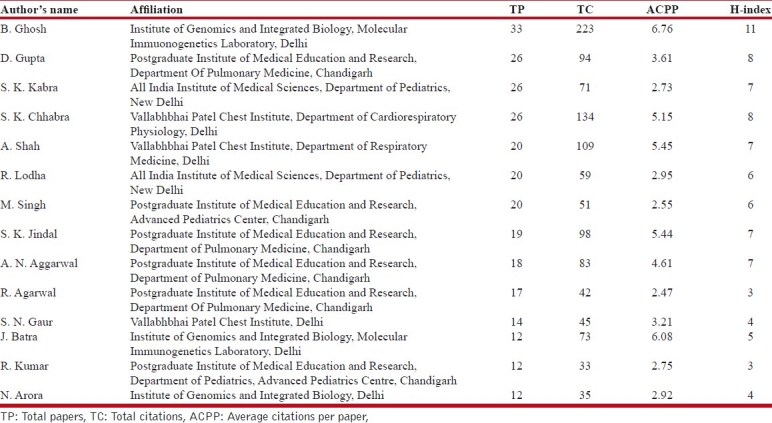
Patterns of research communication
The Asthma research output published in 20 productive journals is presented in Table 10. Of these 20 journals, 5 are of international origin and 15 are of Indian origin. The cumulative publications output of these 20 most productive journals contributes 37.70% share (325 papers) in the country's total output during 1999-2008, witnessing a decrease in publication share from 51.35% during 1999-2003 to 29.11% during 2004-2008.
Table 10.
Number of asthma papers published in most productive journals* during 1999-2008
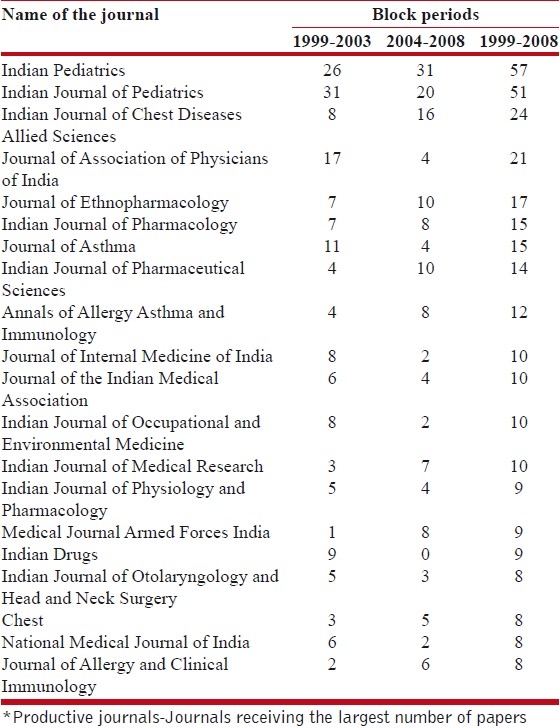
High-cited papers
This section analyzes the characteristics of top 100 most high-cited papers of India in asthma research [Tables 11a-b]. These 100 high-cited papers have received citations (since their publication till 11.07.2010) varying from 14 to 373 during 1999-2008. The cumulative citations received by these high-cited papers were 3372, with an average of 33.72 citations per paper. Of the 100 papers, 69 appeared as articles, 29 as reviews, 1 each as conference paper and short survey. Of these high-cited papers, 45 involve the collaboration and 55 papers zero collaboration. The authors of these high-cited papers are affiliated to 44 Indian institutions and these papers have appeared in 76 journals.
Table 11a.
Patterns of collaboration and citations received of Indian high-cited papers, 1999-2008

Table 11b.
Patterns of institutional affiliation and communication in journals of high-cited papers
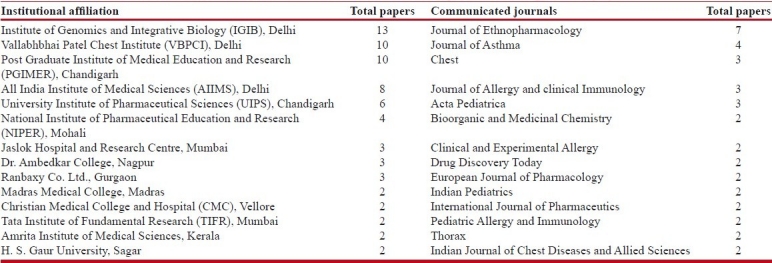
DISCUSSION
We conclude that Indian scientists had published 862 papers in asthma research during 1999-2008 and registered an average citation per paper of 3.43. The cumulative Indian papers witnessed a growth rate of 58.86% for the papers from 1999-2003 to 2004-2008 and achieved the h-index as 33. India ranks 15th position among the top 23 countries in asthma research, with its global publication share of 1.27% and international collaborative publications share of 10.09% during 1999-2008. Among India's major collaborative partners during 1999-2008, USA contributed the largest publications share of 51.72%.
The Indian asthma research output under different subjects shows that the highest research output was from medicine with 62.88% publications share in cumulative Indian publications output during 1999-2008. In terms of impact, the sub-field immunology and microbiology registered the highest citation impact of 6.70 citations per paper during the same period.
The 396 cumulative publications from 13 most productive Indian institutions in asthma accounted for 45.94% share in India's total publications output and registered an average impact of 3.75 citations per paper and an average h-index value of 6.69 during 1999-2008. The 14 most productive Indian authors in asthma together accounted for 31.90% share in national output in asthma and registered an average citation impact of 4.18 citations per paper and an average h-index of 6.14 per author during 1999-2008. The top 100 most high-cited papers of India in asthma research are in citation range of 14-373 during 1999-2008 and have received 3372 citations, with an average of 33.72 citations per paper. The 100 high-cited papers involve 24 with international collaboration (14 bilateral and 10 multilateral) and 21 with national collaboration. The authors of these high-cited papers are affiliated to 44 Indian institutions and these papers have appeared in 76 journals.
It is concluded that the existing Indian research output on asthma is quite low in the global context as reflected from its publication output per thousand population (0.001) and its world publication share (1.27%) during 1999-2008. In addition, the impact and quality of Indian research is low compared to that of select developed and developing countries. Keeping in view the rise in asthma cases in the country, there is a need to increase the Indian research efforts in terms of R and D investments, deployment of more qualified manpower and increased international collaboration to reduce the toll of morbidity and mortality related to asthma disease. Health care system should be strengthened for people with asthma by identifying cost-effective interventions, and upgrading standards and accessibility of care at different levels. Government should invest much more on conducting various studies and clinical and scientific research on asthma. Strategies should be formulated to educate the people about this disease as the appropriate management can only control this disease.
Footnotes
Source of Support: Nil
Conflict of Interest: None declared.
REFERENCES
- 1.World Health Organisation. c2010. [cited 2010 Jun 29]. Available from: http://www.who.int/features/qa/46/en/index.html .
- 2.The New York Times Company. c2010. [cited 2010 Jun 29]. Available from: http://asthma.about.com/od/asthmabasics/a/art_typesofasthma.htm .
- 3.USA; Merck Sharp and Dohme Corp.: A subsidiary of Merck and Co., Inc. c2010-11. [cited 2010 Jun 29]. Available from: http://www.merckmanuals.com/professional/sec05/ch048/ch048a.html#sec05-ch048-ch048a-390 .
- 4.Shabaraya RK, Vishnusharma A, Rajendran SD, Suresh B. Impact of patient education on pulmonary function outcomes in asthmatic patients. Indian J Hosp Pharm. 2008;45:16–9. [Google Scholar]
- 5.World Health Organisation. c2010. [cited 2010 Jun 29]. Available from: http://www.who.int/mediacentre/factsheets/fs307/en/index.html .
- 6.Aggarwal AN, Chaudhry K, Chhabra SK, D’Souza GA, Gupta D, Jindal SK, et al. Prevalence and risk factors for bronchial asthma in Indian adults: A multicentre study. Indian J Chest Dis Allied Sci. 2006;48:13–22. [PubMed] [Google Scholar]
- 7.Jindal SK. Bronchial Asthma: The Indian Scene. Curr Opin Pulm Med. 2007;13:8–12. doi: 10.1097/MCP.0b013e32800ffd09. [DOI] [PubMed] [Google Scholar]
- 8.New Delhi; Ministry of Health and Family Welfare. c2009. [cited 2010 Jun 29]. Available from: http://www.nfhsindia.org/data/india/indch6.pdf .
- 9.Global initiative for asthma/Who initiative. [cited in 2010]. Available from: http://www.ginasthma.com/index.asp?l1=1andl2=0 .
- 10.Klaewsongkram J, Reantragoon R. Asthma research performance in Asia-Pacific: A bibliometric analysis by searching pubmed database. J Asthma. 2009;46:1013–20. doi: 10.3109/02770900903242696. [DOI] [PubMed] [Google Scholar]
- 11.Chen SR, Chiu WT, Ho YS. Asthma in children: Mapping the literature by bibliometric analysis. Revue Francaise d’Allergologie et d’Immunologie Clinique. 2005;45:442–6. doi: 10.1016/j.allerg.2005.08.002. [DOI] [PMC free article] [PubMed] [Google Scholar]
- 12.Groneberg-Kloft B, Scutaru C, Dinh QT, Welte T, Chung KF, Fischer A, et al. Inter-disease comparison of research quantity and quality: Bronchial asthma and chronic obstructive pulmonary disease. J Asthma. 2009;46:147–52. doi: 10.1080/02770900802503115. [DOI] [PubMed] [Google Scholar]
- 13.Poureslami IM, Rootman I, Balka E, Devarakonda R, Hatch J, FitzGerald JM. A systematic review of asthma and health literacy: A cultural-ethnic perspective in Canada. Med Gen Med. 2007;9:40. [PMC free article] [PubMed] [Google Scholar]
- 14.Wikimedia Foundation, Inc. [cited 2010 Jun 29]. Available from: http://en.wikipedia.org/wiki/List_of_countries_by_population .


